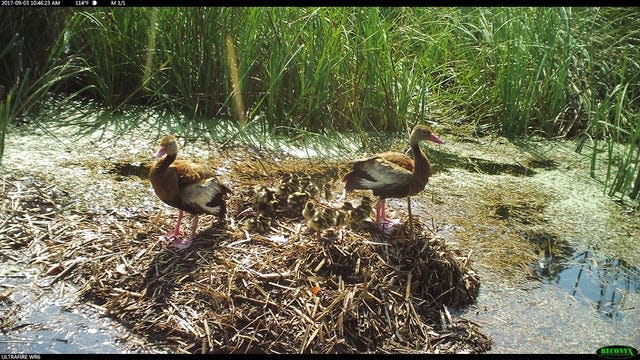Many animals use alligator nests to their benefit | ECOVIEWS
- Oops!Something went wrong.Please try again later.
The ecological importance of American alligators as top predators has long been established.
A paper recently published in the online scientific journal Animals (MDPI) presents new information about these imposing animals. Thomas Rainwater, a research scientist at South Carolina’s Tom Yawkey Wildlife Center and Clemson University, headed the research, assisted by several colleagues.
More: All mothers deserve a special day, especially in nature | ECOVIEWS
Alligators are a keystone species in aquatic habitats across the Southeast, meaning they have a major effect on the environment through their impact on other organisms. Indisputably top predators, they primarily target fish, turtles, snakes, birds and mammals as their prey.
These enormous reptiles get the most press coverage in those rare situations when they eat a dog or, more rarely still, injure a person. The backstory often reveals incautious behavior by said dog or person around an alligator’s home turf.

This paper describes alligators as “ecosystem engineers,” whose actions impact other wildlife.
Many animals noticeably modify their habitat. Beavers build dams; armadillos dig holes; alligators construct nests on land. Those nests, large mounds of vegetation and dirt found near bodies of water in coastal areas from the Carolinas to Texas, are easily distinguishable from other terrestrial features. In early summer the mother lays eggs in the nest, which is an elevated microhabitat.
The study revealed that alligator nests are a valuable commodity for other animals in various ways.
Trail cameras recorded animals engaging with active alligator nests. More than 80 wildlife species took advantage of what amount to small islands on land. The cast of characters associated with alligator nests is impressive. Leading the list: 48 kinds of birds, 19 reptiles and nine mammals. The reason for being atop an alligator nest with a vigilant mother nearby varied.

Animals used nests in more than a half-dozen ways including mating, foraging for prey and feeding on the prey they caught. Some burrowed into the nest itself for shelter; others laid their own eggs. Some traveled over the top of a nest to get to the other side or basked on cool days — a sunny spot nestled in higher vegetation.
Some visitors did what many animals do, including people, they simply stopped to rest a spell, which the investigators refer to as “loafing.” You’d think most critters, of whatever ilk, would avoid the nest of a giant predator and find other spots to do their loafing.
Ironically, some animals, such as small frogs and lizards, sitting on top of a mound in a swamp guarded by a mother alligator may be safer from an attack by other predators than they would be elsewhere. The alligator doesn’t care about the frog or the lizard, but will charge into action if a larger predator enters the scene. An ideal neighborhood watch program for the small reptiles.
Despite the presence of a heavily armed sentry at the guard hole near a gator nest, some thieves managed a successful heist. Wildlife cameras captured opossums, bobcats and raccoons eating eggs or baby alligators, although the predators’ strategies varied. All ate alligator eggs when they could, but raccoons would dig up several eggs, eating some themselves and scattering the rest about. Those might fall prey to an opossum or bobcat that wandered by.
Opossums were twice observed removing only a single egg from a nest, and in both instances the rest of the clutch of alligator eggs hatched successfully. More than one bobcat was observed spying on a nest as the mother took her babies, a few at a time, to the water. When she reached the water, the bobcat would snatch up any remaining babies.
The researchers note that “a diverse assemblage of wildlife uses alligator nest sites ... for a variety of life activities, and these uses differ among and within animal groups.”
Alligators play a critical ecological role for a diversity of native wildlife, and studies such as this one provide an important service by broadening our environmental perspective and demonstrating, once again, the interconnectedness of life.
Whit Gibbons is professor of zoology and senior biologist at the University of Georgia’s Savannah River Ecology Laboratory. If you have an environmental question or comment, email ecoviews@gmail.com.
This article originally appeared on The Tuscaloosa News: How alligator nests support lots of other animals | ECOVIEWS

